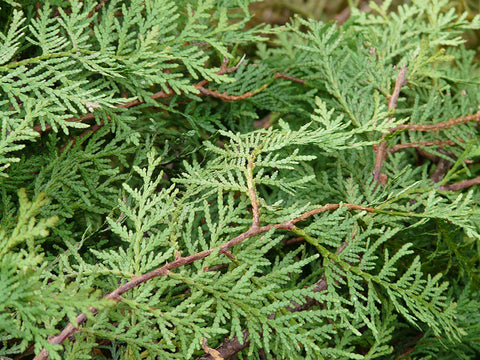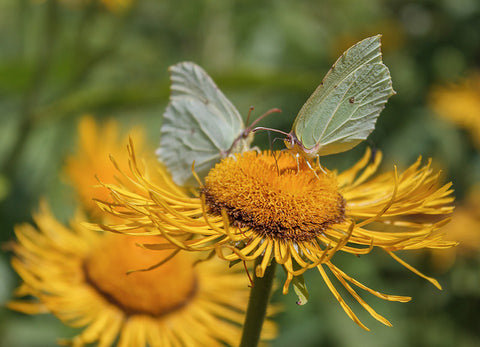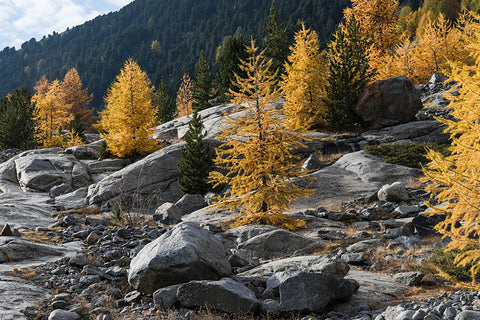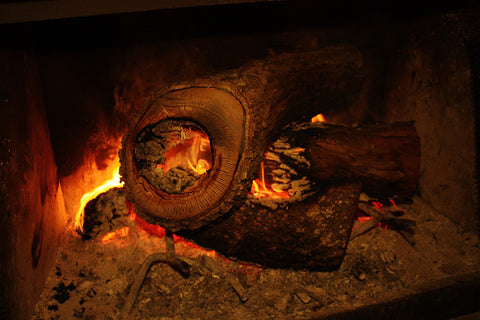Growing up on the sunny side of the Alps, on the gentle slopes that would run down into the fertile valleys of northern Italy, I listened to the fairytales and lore of a people who had lived in those craggy mountains for thousands of years. As is so often the case, these stories celebrated the seasonal shifts that came, reliably, year after year and dictated the rhythms of the harvest, pasture, and health. Many of these stories were linked to plants--and as the weather turned cold and the deep snows came to the high fields, plants like yarrow, nettles, dandelion and clover would retreat and local folk would turn to trees and perennials that could be found and processed into remedies year-round, or to bulbs and fruits that could survive long-term storage.
Another thread in most of these stories was the presence of life and consciousness in every corner: so trees and streams had their guardian spirits, but so did the family hearth, the threshold, and the well. The domestic and natural worlds were part of a single whole, and fairies--both helpful and mischievous--animated it and infused rich meaning into daily life. During the winter months, particular attention was paid to the spirits of the home, and many tales emphasized the value of leaving small gifts and offering to them to ensure safety and comfort during the colder months.
 The berries are still eaten as a source of vitamins in the winter, though they don't have the best flavor. Dried berries can be powdered and mixed with rosehips or other stored fruit to provide an extra wellness-supporting boost.* The Rowan tree, or mountain-ash (Sorbus species), is also known as the "quickbeam", and has a long history of use as an important, protective tree. Its reddish-orange fruits, though a bit astringent, are nutritive and rich in important chemistry that supports seasonal wellness: lots of vitamin C, bioflavonoid pigments, and immune-active provide a serviceable (if not as tasty) alternative to elderberries. Village folk relied on the rowan tree to mediate between their daily lives and the spirit world, usually offering protection from bad luck or the pranks of pixies. To this end, all you need to do is hand a short rowan stick, or a cluster of dry berries, over the front door of your home. Alternatively, larger pieces of wood are carved into amulets and offered to the house spirits to help in finding lost objects that might have been stolen by a cranky goblin. Leaving one of these amulets by the cooking fire overnight, one would often wake to see it was gone and the lost object left in its place. On the way to funerals, corpses were rested under a rowan, to insulate the spirit of the dead person from bad influences. By extension, this practice led to this tree finding an important protective role in all the affairs of the household.
The berries are still eaten as a source of vitamins in the winter, though they don't have the best flavor. Dried berries can be powdered and mixed with rosehips or other stored fruit to provide an extra wellness-supporting boost.* The Rowan tree, or mountain-ash (Sorbus species), is also known as the "quickbeam", and has a long history of use as an important, protective tree. Its reddish-orange fruits, though a bit astringent, are nutritive and rich in important chemistry that supports seasonal wellness: lots of vitamin C, bioflavonoid pigments, and immune-active provide a serviceable (if not as tasty) alternative to elderberries. Village folk relied on the rowan tree to mediate between their daily lives and the spirit world, usually offering protection from bad luck or the pranks of pixies. To this end, all you need to do is hand a short rowan stick, or a cluster of dry berries, over the front door of your home. Alternatively, larger pieces of wood are carved into amulets and offered to the house spirits to help in finding lost objects that might have been stolen by a cranky goblin. Leaving one of these amulets by the cooking fire overnight, one would often wake to see it was gone and the lost object left in its place. On the way to funerals, corpses were rested under a rowan, to insulate the spirit of the dead person from bad influences. By extension, this practice led to this tree finding an important protective role in all the affairs of the household.
 Cedar trees, and in particular the yellow cedar, Thuja occidentalis, still plays an important role for herbalists in winter. Its botanical name Thuja comes from the Greek "thuon", which means "ritual sacrifice". Priests would burn aromatic plants as part of their offering rituals, and the fronds of cedar were (and still are) one of the favorites. In winter, folks would throw these green branches into the fire for similar reasons: to offer gratitude, and cleanse and protect the space.
Cedar trees, and in particular the yellow cedar, Thuja occidentalis, still plays an important role for herbalists in winter. Its botanical name Thuja comes from the Greek "thuon", which means "ritual sacrifice". Priests would burn aromatic plants as part of their offering rituals, and the fronds of cedar were (and still are) one of the favorites. In winter, folks would throw these green branches into the fire for similar reasons: to offer gratitude, and cleanse and protect the space.
This tree is also known as "Arborvitae", or "tree of life". It received this name from French explorer Jacques Cartier, whose expedition became snowbound, and trapped, in Quebec during the winter of 1535. Slowly, an evil disease took hold of them, and the explorers started dying, fatigued and unable to stay warm. We know now that they were dying from scurvy, a vitamin C deficiency. Fortunately for Cartier, a member of the Wyandot tribe (part of the indigenous Huron, who lived in an area from the Great Lakes to the east) showed him how to prepare cedar infusion, which contains an appreciable amount of vitamin C.
We still turn to a gentle Thuja infusion at this time of year to support immune health, and for the occasional incense bundle. Lightly bruise or chop a small frond (about half the size of your palm) for an 8-12 oz cup of tea, boil water and steep, covered, for 3-4 minutes.If you choose to try cedar frond tea, be aware that it will contain small amounts of thujone and that, traditionally, it was only used for short periods of time – no more than a week or so. For the same reason, you should consult with an herbalist or healthcare provider before trying cedar if you are pregnant, nursing, or have any other health condition. * Elecampane (Inula helenium) is a wonderful perennial herb, showing off delicately-petaled yellow flowers in the summer months and finding its home in the moist places of the valley floors. Named "Helen of the fields", it is rumored that Helen of Troy wore some of the flowers in her hair on the day she left home with Paris (a fateful day, as the Greeks remember it, for it marked the beginning of a long and bloody war). Perhaps she had gathered some, as so many still do, for the large and starchy roots. The dried flower-heads, stretching over six feet tall, are easy to find any time of year, and during the colder months served as a reliable indicator that these nourishing roots were available. We think this is how the plant came into common use: as an emergency source of carbohydrates during the cold months. Pretty soon, folks noticed that people who boiled elecampane roots and managed to get past the spicy, warming flavor had healthy lungs all winter long. Since then, we've favored these roots for the excellent bronchial support they provide. You can infuse clean, dry roots into honey, or harvest them fresh and preserve them with 100-proof vodka, taking about 1/2 teaspoon of the resultant tincture 3-4 times a day. And for those who don't mind a little bitterness and spice, bring the roots to a boil and simmer in water to make a powerful tea for winter health. It amazes me to think that the flavor, unique and characteristic, is one that country folk have known well since the time of the Trojan war (and likely way before that).*
Elecampane (Inula helenium) is a wonderful perennial herb, showing off delicately-petaled yellow flowers in the summer months and finding its home in the moist places of the valley floors. Named "Helen of the fields", it is rumored that Helen of Troy wore some of the flowers in her hair on the day she left home with Paris (a fateful day, as the Greeks remember it, for it marked the beginning of a long and bloody war). Perhaps she had gathered some, as so many still do, for the large and starchy roots. The dried flower-heads, stretching over six feet tall, are easy to find any time of year, and during the colder months served as a reliable indicator that these nourishing roots were available. We think this is how the plant came into common use: as an emergency source of carbohydrates during the cold months. Pretty soon, folks noticed that people who boiled elecampane roots and managed to get past the spicy, warming flavor had healthy lungs all winter long. Since then, we've favored these roots for the excellent bronchial support they provide. You can infuse clean, dry roots into honey, or harvest them fresh and preserve them with 100-proof vodka, taking about 1/2 teaspoon of the resultant tincture 3-4 times a day. And for those who don't mind a little bitterness and spice, bring the roots to a boil and simmer in water to make a powerful tea for winter health. It amazes me to think that the flavor, unique and characteristic, is one that country folk have known well since the time of the Trojan war (and likely way before that).*
 No home apothecary would be complete without garlic (Allium sativum). Useful for all manner of things, garlic shines when the weather turns cold and served as a complete winter-wellness pharmacy all by itself. Stored in long braids, or in bushel baskets stashed in a dark, dry cellar corner, this pungent bulb came into the kitchen almost every day to help support circulation and health during the cold months of the year. In northern Italy, Austria and Bavaria, farmers take some of their garlic harvest and smear it on the outside of their front doors to repel the blutsauger - a vampire-like being looking to drain blood and vitality from unsuspecting victims. To keep a corpse from returning as a vampire, you'd shove garlic cloves into the mouth and drive a hawthorn stake through the heart before burial. Rich in pungent compounds, garlic cloves certainly have a powerful, warming spice that supports good blood flow and immune health. But don't smear it on your front door! Instead, try 2-3 cloves a day chopped and simmered in soups or bone broth recipes, or fire-roasted and used as a spread for bread and veggies.*
No home apothecary would be complete without garlic (Allium sativum). Useful for all manner of things, garlic shines when the weather turns cold and served as a complete winter-wellness pharmacy all by itself. Stored in long braids, or in bushel baskets stashed in a dark, dry cellar corner, this pungent bulb came into the kitchen almost every day to help support circulation and health during the cold months of the year. In northern Italy, Austria and Bavaria, farmers take some of their garlic harvest and smear it on the outside of their front doors to repel the blutsauger - a vampire-like being looking to drain blood and vitality from unsuspecting victims. To keep a corpse from returning as a vampire, you'd shove garlic cloves into the mouth and drive a hawthorn stake through the heart before burial. Rich in pungent compounds, garlic cloves certainly have a powerful, warming spice that supports good blood flow and immune health. But don't smear it on your front door! Instead, try 2-3 cloves a day chopped and simmered in soups or bone broth recipes, or fire-roasted and used as a spread for bread and veggies.*
 The larch tree (various Larix species) is an iconic part of the Alpine forest. While the spruces and pines stay green all year, the larches lose their needles each fall, turning a golden color that weaves its way down the hillsides. Aspens in the Rocky Mountains remind me of this, though the larch, with its coniferous habit, is even more striking. Another difference is that larch sap, known as larga' in the mountains, is gummy and more demulcent than the resinous sap of other conifers. Its flavor and texture are pleasant enough that locals chew larga' as a crude gum, and claim that it helps keep them healthy all winter. This may be true: recent research has discovered that the polysaccharides in larch sap, known as arabinogalactans, support good immune function and are similar in structure to polysaccharides found in Echinacea roots. The aromatic volatiles mixed in support good health across the respiratory passages, and this great combination is probably why mountain folk still chew this gum today. One legend tells that the Salige Fräuleins ("beautiful maidens", the companions of Frau Holle, the Elder mother) love the larch trees, and linger underneath them during the summer months. Other say that the larch is the physical form of these maidens - with their golden-colored hair that flashes in fall. People sometimes leave offerings next to particularly old or tall larches, hoping it will win them the graces of these kind fairies. By drinking the tea made from boiling a few tablespoons of inner bark, the larch can help make this hope a reality.*
The larch tree (various Larix species) is an iconic part of the Alpine forest. While the spruces and pines stay green all year, the larches lose their needles each fall, turning a golden color that weaves its way down the hillsides. Aspens in the Rocky Mountains remind me of this, though the larch, with its coniferous habit, is even more striking. Another difference is that larch sap, known as larga' in the mountains, is gummy and more demulcent than the resinous sap of other conifers. Its flavor and texture are pleasant enough that locals chew larga' as a crude gum, and claim that it helps keep them healthy all winter. This may be true: recent research has discovered that the polysaccharides in larch sap, known as arabinogalactans, support good immune function and are similar in structure to polysaccharides found in Echinacea roots. The aromatic volatiles mixed in support good health across the respiratory passages, and this great combination is probably why mountain folk still chew this gum today. One legend tells that the Salige Fräuleins ("beautiful maidens", the companions of Frau Holle, the Elder mother) love the larch trees, and linger underneath them during the summer months. Other say that the larch is the physical form of these maidens - with their golden-colored hair that flashes in fall. People sometimes leave offerings next to particularly old or tall larches, hoping it will win them the graces of these kind fairies. By drinking the tea made from boiling a few tablespoons of inner bark, the larch can help make this hope a reality.*
 The Salige Fräuleins work closely with the lady who lives in the elder (Sambucus species). In fact, the elder mother is revered as one of the chief goddesses of the mountain pantheon, and is responsible for moderating winter's chill and ensuring the health of those who live under her domain. Her retinue courses the countryside and reports back to her, and on special nights, the elder mother herself ventures out bestowing gifts - or punishments, depending - to the hardy folk living on the hillsides. Farmers collect elder flowers around Midsummer, drying them for tea during the winter months (an especially favored remedy for the young ones of the family). Later, in fall, berries go into big pots of jam which will serve to support the family’s health all winter, too (even just one or two spoonfuls a day can be enough).* Everyone shows respect to the elder for the gifts she can provide. One story tells of a hard-working couple, whose flax harvest had failed that year. With no fiber to spin, there was no weaving that winter, nor any fabric that could be made to repair the villagers' clothing during the cold months. The couple had taken to using old pieces of burlap to patch up whomever needed assistance. The elder mother and the salige fräuleins visited the couple one night, wanting to reward them for their hard work and dedication. When they woke, they found a ball of flax thread sitting next to the loom. Immediately, they set to weaving some fabric. But try as they might, the ball would never get smaller: Frau Holle had given them a never-ending ball of flax.
The Salige Fräuleins work closely with the lady who lives in the elder (Sambucus species). In fact, the elder mother is revered as one of the chief goddesses of the mountain pantheon, and is responsible for moderating winter's chill and ensuring the health of those who live under her domain. Her retinue courses the countryside and reports back to her, and on special nights, the elder mother herself ventures out bestowing gifts - or punishments, depending - to the hardy folk living on the hillsides. Farmers collect elder flowers around Midsummer, drying them for tea during the winter months (an especially favored remedy for the young ones of the family). Later, in fall, berries go into big pots of jam which will serve to support the family’s health all winter, too (even just one or two spoonfuls a day can be enough).* Everyone shows respect to the elder for the gifts she can provide. One story tells of a hard-working couple, whose flax harvest had failed that year. With no fiber to spin, there was no weaving that winter, nor any fabric that could be made to repair the villagers' clothing during the cold months. The couple had taken to using old pieces of burlap to patch up whomever needed assistance. The elder mother and the salige fräuleins visited the couple one night, wanting to reward them for their hard work and dedication. When they woke, they found a ball of flax thread sitting next to the loom. Immediately, they set to weaving some fabric. But try as they might, the ball would never get smaller: Frau Holle had given them a never-ending ball of flax.
 In this environment that could be harsh and dangerous, especially in winter, humans found support, meaning and even companionship in the world of plants and the unseen spirits that commingled with them. During the cold months, gathered around the fire, they spun tales of how garlic, larch trees, and the elder mother were looking out for them. The plants--living, capable of agency and compassion, and allies to us humans--became essential partners to help maintain healthy bodies, minds and spirits. And while today we may not be in danger from the blutsauger, nor plagued with scurvy, we can still benefit from the gifts our partners bring to the table. May we all enjoy great health during winter, and find wild spirits on our snowy walks.*
In this environment that could be harsh and dangerous, especially in winter, humans found support, meaning and even companionship in the world of plants and the unseen spirits that commingled with them. During the cold months, gathered around the fire, they spun tales of how garlic, larch trees, and the elder mother were looking out for them. The plants--living, capable of agency and compassion, and allies to us humans--became essential partners to help maintain healthy bodies, minds and spirits. And while today we may not be in danger from the blutsauger, nor plagued with scurvy, we can still benefit from the gifts our partners bring to the table. May we all enjoy great health during winter, and find wild spirits on our snowy walks.*

